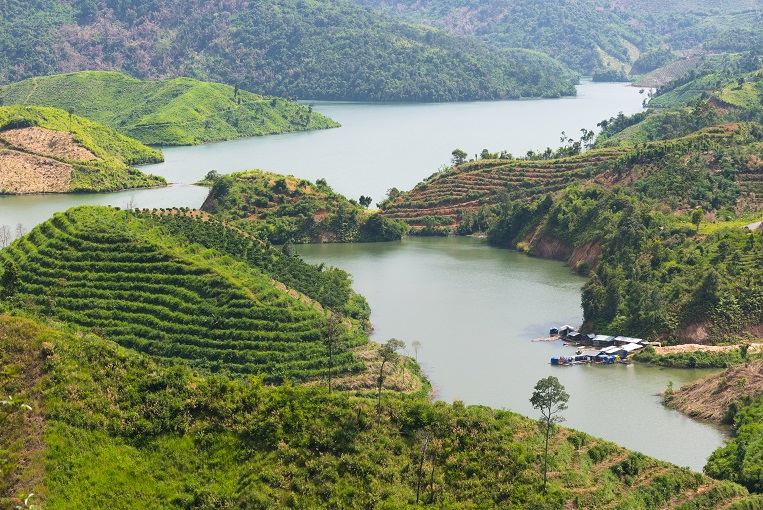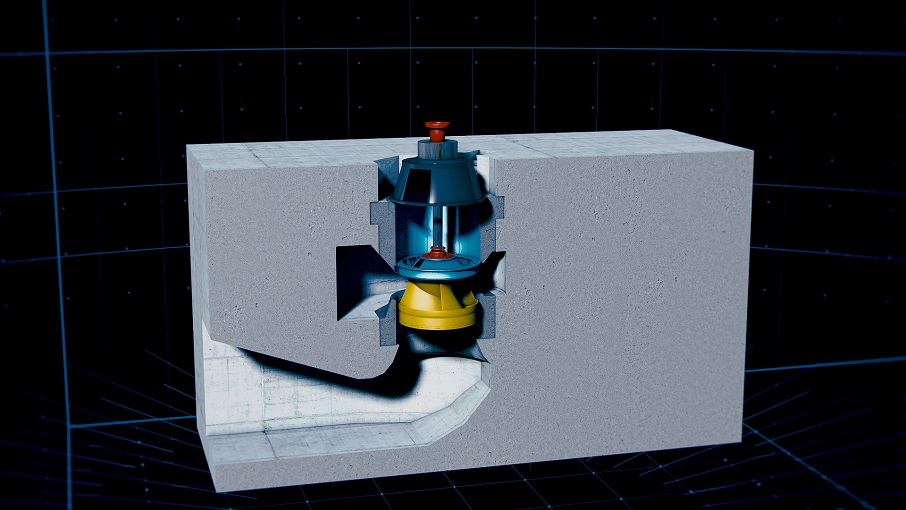

To protect a vital tea-producing area in northern Vietnam from flooding a new pumping station is to be built. ANDRITZ has supplied two concrete volute pumps with high flow rates and very low heads, together with the complete electromechanical equipment.
In 2017, Vietnam achieved exports in the amount of US$36.5 billion for agricultural products. The country in southern Asia is now aiming at 3.05% growth to reach an export figure of up to US$40.5 billion for 2018. These figures illustrate the highly impressive transition in Vietnam from being a country plagued by famine to one of the world’s largest exporters of foodstuffs. This transformation began in the 1980s. That was when Vietnam underwent a drastic change of role from importer to exporter.
Because of trade liberalization and agricultural reforms, the value of agricultural exports rose significantly. Today, Vietnam is the top exporter worldwide for black peppercorns and cashew nuts. In addition, the country ranks among the top 10 exporters of coffee, coconuts, rice, rubber, sweet potatoes, and tea.
Climate change In view of this, agriculture is not just an important part of the GDP, but also continues to be one of the country’s most important employers. However, it is confronted time and time again with adverse weather conditions. With a total annual precipitation of 640 billion m3,
Vietnam is certainly one of the rainiest countries on earth, but this rainfall is not always distributed ideally over time and regions. 75–85% of this volume falls within four to five months during the monsoon period, mainly in the northern part of the country. The south-easterly monsoon occurring during this period brings severe weather every year. Heavy and incessant rain results in rivers and streams bursting their banks regularly and causing flooding.
In 2008, flooding in Vietnam cost hundreds of lives. The capital Hanoi, where 20 people died in the floodwaters or after being struck by lightning, was also particularly badly hit. In addition to the lives lost, the severe weather resulted in a shortage of drinking water and basic foodstuffs.
Lives lost Following heavy rainfall in 2013, more than 30 people lost their lives and over 100,000 houses were flooded. In October and November 2016, Vietnam was struck by a total of three exceptionally heavy storms. Once more, flooding claimed 40 victims and again destroyed 100,000 houses as well as 1300 hectares of paddy fields. The figures for 2017 were similar.
Climate change is making this situation continually worse. According to current forecasts by the IPCC (International Panel on Climate Change), climate change will increasingly affect countries on the equator.
In this respect, Vietnam is ranked among the countries with the highest risk. At an average emissions level, the scenario for 2080–2099 is predicted as having even higher annual rainfall in the months that already experience the heaviest rain. This was heralded only recently in the summer of 2018 by the tropical storm Son Tinh, which caused numerous floods.
Tea business As a result, different strategies have been developed in the past few decades to deal with these climate challenges, but also with the dynamic economic growth in the water sector. In addition to refurbishment and expansion of existing irrigation systems, these strategies also include building flood protection systems.
Among them is the pumping system in the Thanh Thuy district of PhuTho Province. PhuTho is situated in the north eastern part of the country and is considered one of its poorest regions. The most important industry in the region is the cultivation of tea and produces around 100,000 tons per annum, 80,000 tons of which are exported.
To increase this productivity and crop yield to improve not only the living standards and the ecological environment, but also to reduce poverty for farmers in the affected areas a new pumping station, Doan Ha, is to be built. It will have the capacity to reliably irrigate up to 672,000 m2 of paddy land creating an infrastructure for the formation of a large sample field. In addition to irrigation, the required two pumps to be installed in the station will also be able to drain up to 2,122,000 m2 of agricultural land if necessary.
After coming out best in the review process for the tender in terms of meeting the project requirements and providing detailed proof thereof, ANDRITZ was awarded the order to supply two concrete volute pumps together with the complete electromechanical equipment for the pumping station Doan Ha in a joint venture with a Vietnamese partner, Haiduong Pump Manufacturing., JSC (Hapuma).
No newcomer The international technology group ANDRITZ is not a newcomer to Vietnam. In addition to equipping numerous hydropower plants, such as Chau Tang, Nam Na 1 or Song Lo 6, ANDRITZ also supplied ten vertical line shaft pumps in 2018 for the largest flood protection plant in Vietnam – Yen Nghia, near Hanoi. The station and its pumps were specially designed and built for flood protection purposes. This means that the pumps are only activated in case of need and then must pump away large amounts of water at low head in the shortest possible time.
Vertical line shaft pumps could also be used for the Doan Ha pumping system. However, the general framework of this project makes concrete volute pumps much more suitable. This is due to the significant advantage they provide in applications with high flow rates and very low heads. Because of the special design between the inlet and outlet, the pump is extremely compact, leading to significantly lower construction costs for the overall plant.
Different designs Based on the Kaplan turbine design principle, which ANDRITZ has been installing successfully all over the world since 1926, the technology for concrete volute pumps was adapted and carefully considered concreting procedures were developed that ensure rapid execution and exact results. The concrete volute pump consists basically of the concrete casing and the removable pump unit. This part can be removed easily for maintenance purposes.
The concrete casing is resistant to any kind of water and requires no maintenance whatsoever. Both technologically and economically, concrete volute pumps are the best solution when it comes to transporting large volumes of water. The concrete casing has a long-life cycle and is resistant to erosion as well as to brackish and sea water. And the material costs are also low.
There are three different ways of building a pump of this kind: concreting on site, a construction with steel segments, or a design with prefabricated elements. The choice of construction is not arbitrary but is defined by the respective requirements of the pump in each case and the general framework of the project.
Concreting on site is the most economical solution first and foremost for particularly large concrete volute pumps used to transport brackish and sea water, while steel segments pay off especially with a small number of small pumps that do not have to convey sea water. Otherwise an additional, expensive coating or a construction made of stainless steel would be needed.
For the design with prefabricated elements as used in Doan Ha, the pump volute is divided into a certain number of concrete blocks. The individual parts are manufactured according to ANDRITZ’s specification in a local Vietnamese concrete factory and then forwarded to the project location and assembled directly on site.
Design advantages The advantages of this design are that there is no particularly exact and time-consuming work to be performed on the site and that the concrete volute surface is resistant to brackish or sea water, providing the same results as concreting on site.
The concrete volute pumps designed especially for the Doan Ha project each achieve a flow rate of 12.5 m3 per second at a maximum head of 8.15 m. Each of the pumps has a 1,000-kW motor for this purpose. The pumps reach an efficiency of up to 88%, while the motors can achieve efficiencies of up to 86% at 100% output.
The pumps are designed for transporting natural water, i.e. river water and contaminated water, i.e. flood water. Both motors and pumps are monitored fully automatically by a monitoring and control system. The pumps and their components are designed for more than 70,000 operating hours. Completion including delivery and erection of the pumps in the pumping station is scheduled for 18 months after signing of the contract, which is mid-2020.





